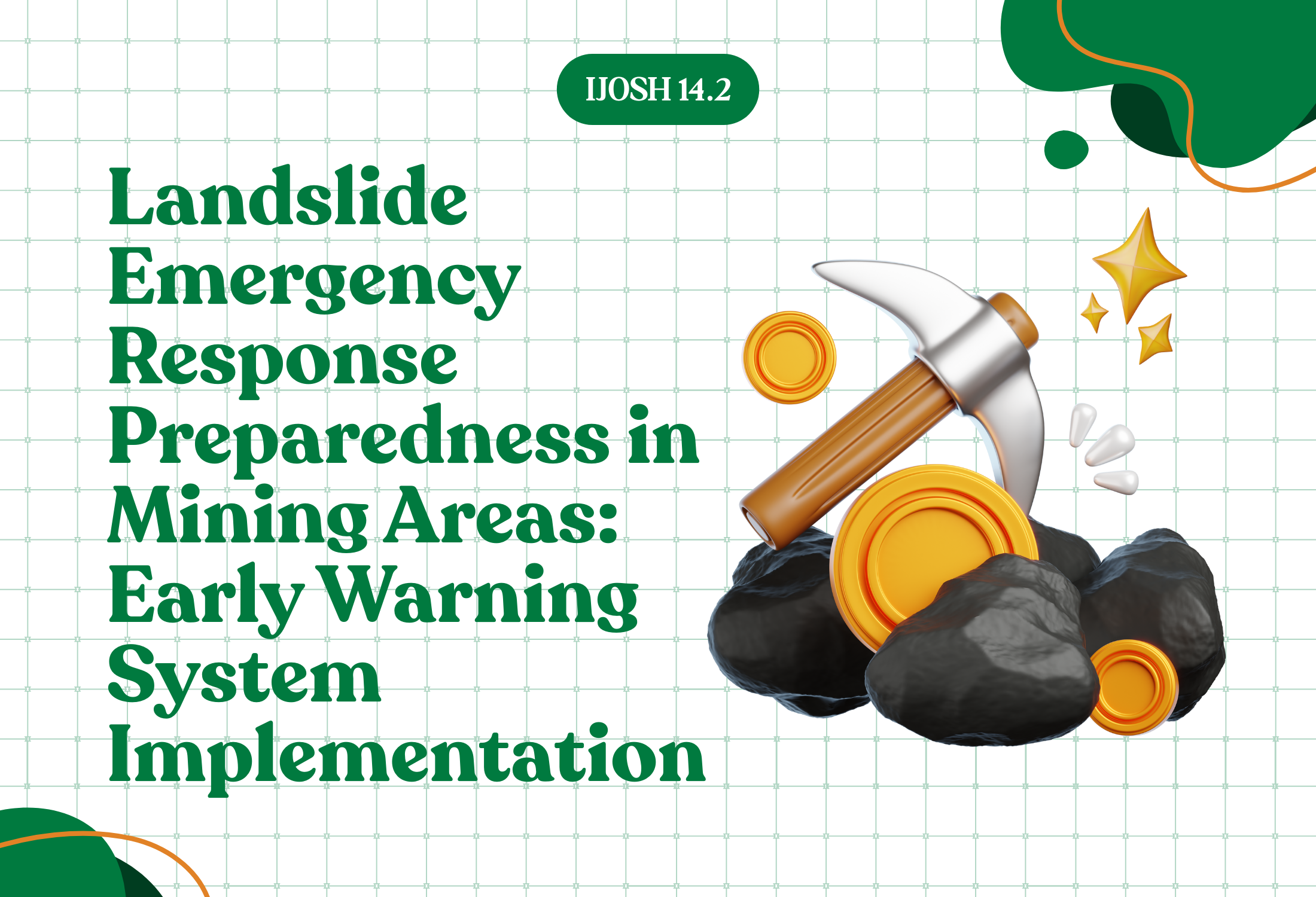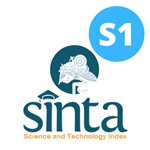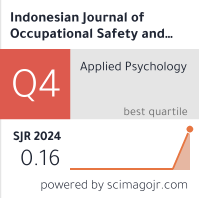Landslide Emergency Response Preparedness in Mining Areas: Early Warning System Implementation

Downloads
Introduction: Coal mining operations present serious risks due to landslip risks, necessitating the use of efficient early warning systems and emergency preparation. This paper examines the use of an early warning system called LASER (Land Sliding Alert) in comparison to direct direction from the supervisor using conventional radio at the KPC Sangatta mining operation of PT. Pamapersada Nusantara. The study aims to evaluate how the system affects workers' response to approaching landslides as well as their degree of preparedness. Method: The researchers collected 12 data over 3 months from the emergency drill and continue with observations, interviews and document review. Substantive data including risk management screening, landsliding warning accuracy and response were assessed so response time from worker can be gathered. Result: The results displayed a better performance in the LASER early warning system than conventional land sliding alert, achieving 100% reactivity and increased pace of evacuation. The system uses Internet of Things (IoT) to ensure immediate notification for all buildings at the same time using sirens and radio equipment that leads to faster reaction. The LASER system is 96% effective at warning employees in the statistical research. Conclusion: The research demonstrates that the LASER-based early warning system is extremely efficient in monitoring dangerous slope conditions in mining areas. It effectively addresses the issue of response time and ensures that personnel are well-prepared to respond promptly and effectively. The study emphasises the significance of employing sophisticated monitoring systems and resilient emergency protocols to mitigate the hazards associated with landslides. The application of the landsliding alert can be implemented in other mining areas, especially in open pit mining activities and make contributions ultimately result in a workforce that is safer and mining operations that are more sustainable.
Akbar, S. et al. (2024) ‘Crisis Communication Effectiveness In Disaster Management: Case Studies And Lessons’, International Journal of Social and Education (INJOSEDU), 1(2), pp. 401–411.
Alam, S.R.N. and Syarif, E. (2020) ‘Studi Tingkat Pengetahuan Kebencanaan Terhadap Sikap Kesiapsiagaan Masyarakat Dalam Menghadapi Bencana Tanah Longsor Di Kecamatan Parangloe Kabupaten Gowa Tahun 2019’, Jurnal Environmental Science, 2(2), pp. 162-169.
Bachri, S. et al. (2021) ‘Landslide Risk Analysis in Kelud Volcano, East Java, Indonesia’, Indonesian Journal of Geography, 53(3). Available at: https://doi.org/10.22146/IJG.40909.
Bar, N. and McQuillan, A. (2021) ‘Q-slope and SSAM Applied to Excavated Coal Mine Slopes’, MethodsX, 8, pp. 1-8. Available at: https://doi.org/10.1016/j.mex.2020.101191.
Basofi, A., Fariza, A. and Kamal, I.M. (2019) ‘Mitigation and Emergency Management System of Landslide in Ponorogo District, Indonesia’, International Journal on Informatics Visualization, 3(2), pp. 100-107. Available at: https://doi.org/10.30630/joiv.3.2.222.
De Graff, J.V. (2019) ‘Ensuring Successful Landslide Investigation during an Emergency Response’, Environmental and Engineering Geoscience, 25(2), pp. 141-154. Available at: https://doi.org/10.2113/EEG-2165.
Devanand, V.B. et al. (2023) ‘Innovative Methods for Mapping the Suitability of Nature-Based Solutions for Landslide Risk Reduction’, Land, 12(7), pp. 1-15. Available at: https://doi.org/10.3390/land12071357.
Fang, H. et al. (2023) ‘A New Approach to Spatial Landslide Susceptibility Prediction in Karst Mining Areas Based on Explainable Artificial Intelligence’, Sustainability, 15(4), pp. 1-22. Available at: https://doi.org/10.3390/su15043094.
Geng, S., Hou, H. and Geng, J. (2021) ‘The Mechanism of Operation Effectiveness of Emergency Shelter Rescue Systems’, Sustainability, 13(10), pp. 1-16. Available at: https://doi.org/10.3390/su13105540.
Glueer, F. et al. (2021) ‘Robotic Total Station Monitoring in High Alpine Paraglacial Environments: Challenges and Solutions from the Great Aletsch Region (Valais, Switzerland)’, Geosciences, 11(11), pp. 1-19. Available at: https://doi.org/10.3390/geosciences11110471.
Lian, X. et al. (2024) ‘Research on Identification and Location of Mining Landslide in Mining Area Based on Improved YOLO Algorithm’, Drones, 8(4), pp. 1-18. Available at: https://doi.org/10.3390/drones8040150.
Liu, F. et al. (2021) ‘Rock Landslide Early Warning System Combining Slope Stability Analysis, Two-stage Monitoring, and Case-based Reasoning: A Case Study’, Bulletin of Engineering Geology and the Environment, 80(11), pp. 8433–8451. Available at: https://doi.org/10.1007/s10064-021-02461-6.
Matunhay, L.M. (2022) ‘Disaster Preparedness and Sensitivity Level among Higher Education Institution Students’, International Journal of Disaster Management, 5(2). Available at: https://doi.org/10.24815/ijdm.v5i2.27150.
Menon, V. and Kolathayar, S. (2022) ‘Review on Landslide Early Warning System: A Brief History, Evolution, and Controlling Parameters’, in Springer Tracts in Civil Engineering. Springer Science and Business Media Deutschland GmbH, pp. 129–145. Available at: https://doi.org/10.1007/978-981-16-5312-4_10.
Prasetyaningsih, R., Mappewali, A. and Naniwarsih, A. (2023) ‘Empowering Students Disaster Literacy: An Effort to Decrease Disaster Risk towards Reading Aloud Strategy’, International Journal of Health, Economics, and Social Sciences (IJHESS), 5(3). Available at: https://doi.org/10.56338/ijhess.v5i3.3789.
Solikhah, M.M., Krisdianto, M.A. and Kusumawardani, L.H. (2020) ‘Pengaruh Pelatihan Kader Tanggap Bencana Terhadap Kesiapsiagaan Bencana’, Jurnal Ilmiah Ilmu Keperawatan Indonesia, 10(04). Available at: https://doi.org/10.33221/jiiki.v10i04.800.
Stanley, T.A. et al. (2021) ‘Data-Driven Landslide Nowcasting at the Global Scale’, Frontiers in Earth Science, 9. Available at: https://doi.org/10.3389/feart.2021.640043.
Wang, W. et al. (2022) ‘Shallow Failure of Weak Slopes in Bayan Obo West Mine’, International Journal of Environmental Research and Public Health, 19(15). Available at: https://doi.org/10.3390/ijerph19159755.
Zhao, Z., Lyu, H. and Kang, S. (2022) ‘Risk Assessment of High Slope Landslide in Open-pit Mine based on Comprehensive Geophysical Prospecting’, in IOP Conference Series: Earth and Environmental Science. Available at: https://doi.org/10.1088/1755-1315/983/1/012082.
Zhuge, R. et al. (2024) ‘Evaluation of Emergency Drills Effectiveness by Center of Disease Prevention and Control Staff in Heilongjiang Province, China: An Empirical Study using the Logistic-ISM Model’, Frontiers in Public Health, 12. Available at: https://doi.org/10.3389/fpubh.2024.1305426.
Zulkarnain, H. et al. (2024) ‘Pelatihan Kesiapsiagaan Bencana Tanah Longsor Dan Bls Untuk Meningkatkan Pengetahuan Relawan “Destana” Di Ngebel Ponorogo’, Diseminasi: Jurnal Pengabdian kepada Masyarakat,6(1), pp. 105 - 116.

This work is licensed under a Creative Commons Attribution-NonCommercial-ShareAlike 4.0 International License.

In order to be accepted and published by The Indonesian Journal of Occupational Safety and Health, Author(s) who submit an article should complete all the review process. The copyright of received articles assigned to the The Indonesian Journal of Occupational Safety and Health and Department of Safety and Health, Universitas Airlangga as publishers of the journal. The intended copyright includes the rights to publish articles in various forms (including reprints).
The Editorial Team of The Indonesian Journal Of Occupational Safety and Health and Department of Safety and Health strive to ensure that no errors occur in the articles that have been published, both data errors and statements in the article.
Users of this website will be licensed to use materials from this website following the Creative Commons Attribution-NonCommercial-ShareAlike 4.0 International License. No fees charged. Please use the materials accordingly.
------------------------------------------------------------------------------------------------------------------------------------------------------------------------------------------
Attribution ” You must give appropriate credit, provide a link to the license, and indicate if changes were made. You may do so in any reasonable manner, but not in any way that suggests the licensor endorses you or your use.
NonCommercial ” You may not use the material for commercial purposes.
ShareAlike ” If you remix, transform, or build upon the material, you must distribute your contributions under the same license as the original.







 How to Submit Articles in OJS
How to Submit Articles in OJS

























